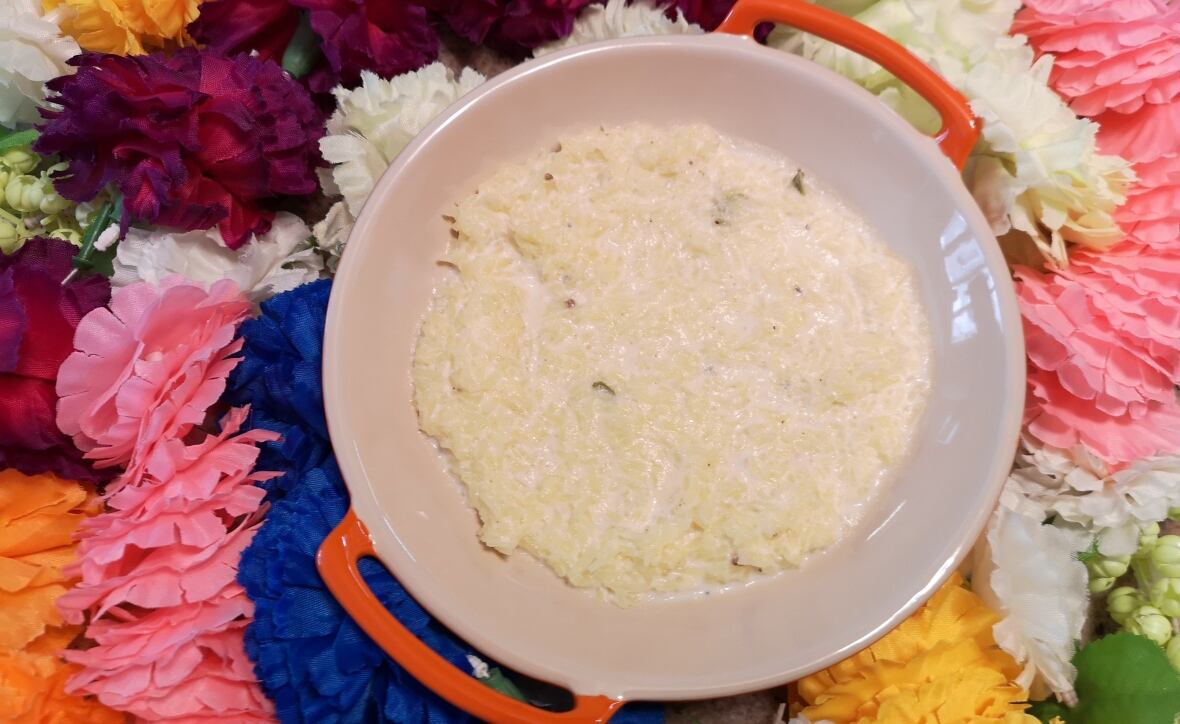Sikh festival of Vaisakhi brings spring food favourites to community
'From my heart, I want everyone to be a part of it,' chef Jasjit Kaur says

April is a month of diverse celebrations and observances from Ramadan to Passover to Easter.
The middle of month is also Vaisakhi, a spring harvest festival and new year for people of the Sikh faith.
Cambridge-based chef, culinary instructor and broadcaster Jasjit Kaur refers to the celebration, which takes place on April 14 this year, as "an ode to Mother Nature." Kaur specializes in Indian cooking teaching workshops, online classes and radio and television broadcasts.
"It's the first month of the Hindu calendar and harvest time of rabi, which is wheat crops, in Punjab, a region rich in agriculture," Kaur said.
Rabi crops, such as wheat, oats, barley, pulses and oilseeds, are planted in winter and harvested in spring.
"Food plays an integral role with friends and family gathering in the evening for special dishes. Food connects everyone in the community," she said.
One of those special dishes made for community gatherings in the Gurdwara (the Sikh temple) is the sweet karah prashad, Kaur says.
"It's made with whole wheat atta flour, sugar and ghee. It's very special."
'Everything is in spring mode'
While Vaisakhi, also known as Baisakhi, is an important Sikh and Punjabi celebration, it's also a secular festival for many Muslims and Christians in India.
At least pre-COVID, Vaisakhi parades took place in major centres in Canada. The annual Surrey Vaisakhi Khalsa Parade (cancelled this year), has drawn half a million spectators in the past.
During Vaisakhi, you will notice vibrant yellow and golden colours in the food and even clothing.
"Everything is in spring mode," Kaur said. "Harvest, vegetables, flowers. Wheat is golden and yellow hues. Yellow and orange are considered (to show) selflessness, spirituality and dedication."
Gatherings at Gurdwara include communal cooking and sharing of food where, it seems, having too many cooks in the kitchen is not a problem.

"For langar wali dal (a pulse dish), you won't even have a recipe because everyone is contributing and making it," Kaur says. "It's one of the tastiest dal ever."
The Punjabi dish is a slowly simmered lentil dish that includes ghee, tomatoes, onions and spices, including red chili powder, which is served at community meals.
From aloo gobi to mango lassi
Kaur says that other popular dishes include chickpea curry, as well as the potato-cauliflower mixture known as aloo gobi that is found at many Indian restaurants.
"Lassi is a drink made with yogurt. Summer is coming and we enjoy the flavours of plain lassi or mango lassi," Kaur said of the popular beverage.
Another dish that has a role at the festive Vaisakhi table – and which is found at virtually any Indian restaurant – is rice pudding, Kaur says.
"It's also known as kheer," she said. "It's very satisfying to the sweet tooth, I can guarantee that. I love it, and it's easy to make at home."
A few ingredients and a bit of time make the dish relatively simple to make in a saucepan, Kaur says: whole milk, sugar, basmati rice and cardamom, with nuts like almonds optional. (Kaur's kheer recipe is below.)
"While you're stirring, add all your love to the kheer," she says. "When love is in there, we have everything and the rice pudding will be sweeter and more tasty. That's my secret to any recipes I cook."
While the various Vaisakhi dishes are served within the homes of the Sikh community and at Gurdwara, they are much more inclusive, according to Kaur, who says sharing with the larger community is important too.
"It's a multicultural society. Vaisakhi is not limited to friends and family. All Canadians can be part of this festival," she says. "From my heart, I want everyone to be a part of it. Being here as a proud Canadian, I love doing that."

Kheer (rice pudding) recipe from Jasjit Kaur
Ingredients
1 litre milk, 3 per cent homogenized is preferred
½ cup cream (optional)
3-4 green cardamom seeds, coarsely crushed
¼ cup basmati rice (soaked for 30 minutes and drained)
½ cup sugar (or to taste)
10-15 almonds, chopped (optional)
Method
On low heat, add milk and cardamom to a heavy-bottomed saucepan. Bring to a gentle boil while stirring so the milk won't stick to bottom of pan.
Once it boils, add the soaked and drained rice and reduce heat to low. Continue to stir until the rice is fully cooked. Add the sugar and stir for another few minutes until the desired consistency is reached. Garnish with chopped almonds if preferred.
Serve warm or cold. Add some milk to leftover and refrigerated kheer to loosen its consistency.

